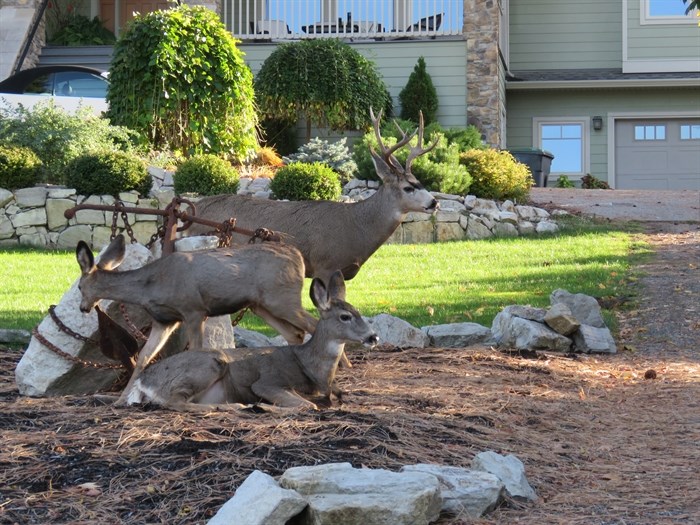
Deer make themselves at home outside an Okanagan residence.
Image Credit: B.C. Conservation Service
July 05, 2016 - 1:10 PM
THOMPSON-OKANAGAN - Deer attacks are becoming more common in the region, and people are mostly to blame, according to the B.C. Conservation Service.
Since the beginning of April, conservation officers received more than 200 deer-related complaints across the Thompson-Okanagan. Specifically, Kamloops saw 27 calls, Vernon 45, and Kelowna and Penticton a whopping 74 and 92 respectively.
“Our urban deer populations seem to be growing at an alarming rate,” conservation officer Ken Owens says.
And with that increase, conflicts with people, particularly those walking dogs, are also on the rise. During fawning season, which starts around the end of May and beginning of June, Owens says there were several incidents where mother deer charged, and in some cases attacked, dogs in the Okanagan.
“Deer are hard-wired to protect their fawns. They will aggressively protect them,” Owens says.
Still think it's cute to feed wildlife? We asked the conservation service for some photos of urban deer, and while they aren't pretty, they show us why it's best that wildlife stays in the wild. You can view those images here (GRAPHIC CONTENT WARNING).
He recounts several cases over the Canada Day long weekend alone where deer advanced on people and their dogs, and says a couple weeks ago, a deer stomped a dog to death in the Upper Mission area of Kelowna.
“We are seeing a lot more of that,” Owens says.
And it’s not just in rural hiking areas. Most of the incidents are right in urban areas. This past weekend, Owens says a man walking his dog along the greenway by the Delta Grand Hotel in Kelowna had an encounter with a doe.
“We’re continually having to tell people, ‘find another place to walk your dog,’” Owens says. “Your dog could get hurt or killed, or you could get hurt.”
One possible reason behind the burgeoning deer population could be the prime foraging habitat left behind by the Kelowna Mountain wildfire of 2003, Owens says.
But the biggest problem is people feeding deer, either intentionally or not. Owens says it’s surprisingly common to find people leaving out things like straw bales, apples, bird seed, and compost for the purpose of feeding deer. And while people might have kind intentions, it’s not helping us, and it’s definitely not helping the deer.
“We need to keep wildlife wild,” Owens says.
Feeding deer leads to increased population density, which in turn can cause disease outbreaks, poor body condition, increased vehicle collisions, and more conflicts with humans.
The best way to help deer is to leave them alone, Owens says.
Another problem Okanagan conservation officers have had is people touching or moving fawns.
“Fawns are cute and defenceless and they may look lonely but baby deer should not be touched or moved. Mother deer leave their young alone for long periods of time,” Owens says.
To avoid attracting predators, a mother deer may only return a few times a day to nurse and it’s typical for fawns to lie in vegetation for hours at a time especially in the first two weeks of their lives when they aren’t strong enough to follow their mothers.
It is illegal to touch or move fawns, and Owens says a woman was recently charged and convicted in Kelowna for doing so.
In addition to not feeding deer, or leaving deer attractants in your yard, other ways to deter them include: trimming back cover they might use for bedding, installing motion activated lights and sprinklers, fencing orchards and crops, and chasing deer from your property whenever they appear. (Remember, however, that it is illegal for you or your dog to injure deer.)
Never approach a deer. If your presence creates a response from the deer, like a change in stance, ear position or physical movement, you are too close. Give the deer plenty of space (15 to 20 metres) and leave the area.
If a deer does attack you, try to stay upright since they inflict injury by striking with their hooves. Cover your head with your arms and back off to shelter.
For wildlife conflict issues, contact the Conservation Officer Service at Report All Polluters and Poachers: RAPP 1-877-952-7277.
To contact a reporter for this story, email Charlotte Helston or call 250-309-5230 or email the editor. You can also submit photos, videos or news tips to the newsroom and be entered to win a monthly prize draw.
We welcome your comments and opinions on our stories but play nice. We won't censor or delete comments unless they contain off-topic statements or links, unnecessary vulgarity, false facts, spam or obviously fake profiles. If you have any concerns about what you see in comments, email the editor in the link above.
News from © iNFOnews, 2016